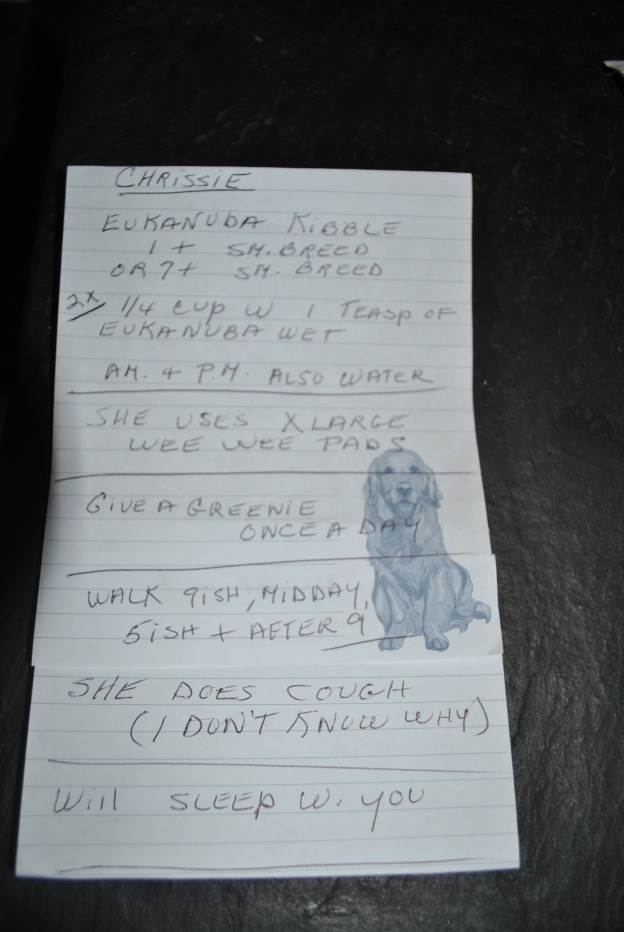My friend Lucy just had a medical emergency that took her away from home and her beloved toy poodle, Chrissy, for six weeks. Another dog lover took Chrissy for a few days but couldn’t keep her. Was Chrissy going to be homeless? People have dumped pets in the street for less.
Clearly this kind of emergency is something all pet lovers need to plan for.
You can’t wait till disaster strikes to think about who will walk the dog and feed the cat if you are temporarily out of commission. Whether you have a boarding kennel lined up or need to phone a friend, you need to plan ahead.
Here’s what to do.
Make a list.  First, think about what you do daily and make a list. “Walk the dog at 7:30 am, 2:30 pm, and again at 9:00 pm; dry food in the morning, wet at night.” Take a few pictures so someone else knows, for example, which scoop you measure food with. If your daily routine involves medication, take lots of photos and mark any measuring devices, such as a syringe, with permanent marker to show exactly how much to use. Here’s the list Chrissy’s temporary caretaker made. You notice she adds the all-important information that Chrissy “will want to sleep with you.”
First, think about what you do daily and make a list. “Walk the dog at 7:30 am, 2:30 pm, and again at 9:00 pm; dry food in the morning, wet at night.” Take a few pictures so someone else knows, for example, which scoop you measure food with. If your daily routine involves medication, take lots of photos and mark any measuring devices, such as a syringe, with permanent marker to show exactly how much to use. Here’s the list Chrissy’s temporary caretaker made. You notice she adds the all-important information that Chrissy “will want to sleep with you.”
Gather supplies.
Next think about what supplies you need to do those things—bird seed, pee pee pads, cat carrier—and add that to your list. Don’t forget your pet’s favorite toy. Make sure you always have a few days’ worth of the essentials in the house at all times. Here’s what Chrissy came with– plus winter coats.
Decide who can handle different tasks.
After that, consider who could manage the different things your pet needs. The neighbor who loves cats may not be willing to give your diabetic kitty her insulin injections. Or walk your 50-pound dog. You may have to divide your pets and tasks to get it all done.
Once you have a list of prospective caregivers, talk to them and get their OK. Double check that their whole family is on board with having your 65-lb dog, who needs three walks a day, for a two-week sleepover. Give them a copy of your instructions and print a copy to hang on your refrigerator in case the first list gets lost.
Remove obstacles.
The next step is to think about any obstacles that might get in the way. Will building management allow your volunteer caretaker to have a pet, even for a short time? Are your pet’s license and vaccines up to date in case he needs to go to a boarding facility? If your pet gets sick, which veterinarian should she go to, yours or your caregiver’s?
Make a long-term plan.
Finally, do some long-term planning. Do you have a Plan B in case your first-choice caregiver is out of town or out of patience? What’s to be done if your medical problem causes a long-term or permanent separation? Can you afford to give your friend some help with expenses in exchange for adopting your furry friend into a safe, loving home?
How it all turned out. In the end, Chrissy was not homeless. Lucy had discussed this kind of emergency with her regular pet sitter, who kept Chrissy till someone else could take over. The sitter wrote extensive notes, packed everything a little dog could need, and generously shared her expertise as a pet professional. Chrissy settled into a new family in a new neighborhood until her person was strong enough to come home.
In fact, knowing her dog was waiting inspired Lucy to work extra hard in physical therapy, so she could take Chrissy for her usual walks in the park.
We’d love to hear about your experience caring for a friend’s pet. What do you wish you’d known? What tips can you share with your fellow animal lovers?
